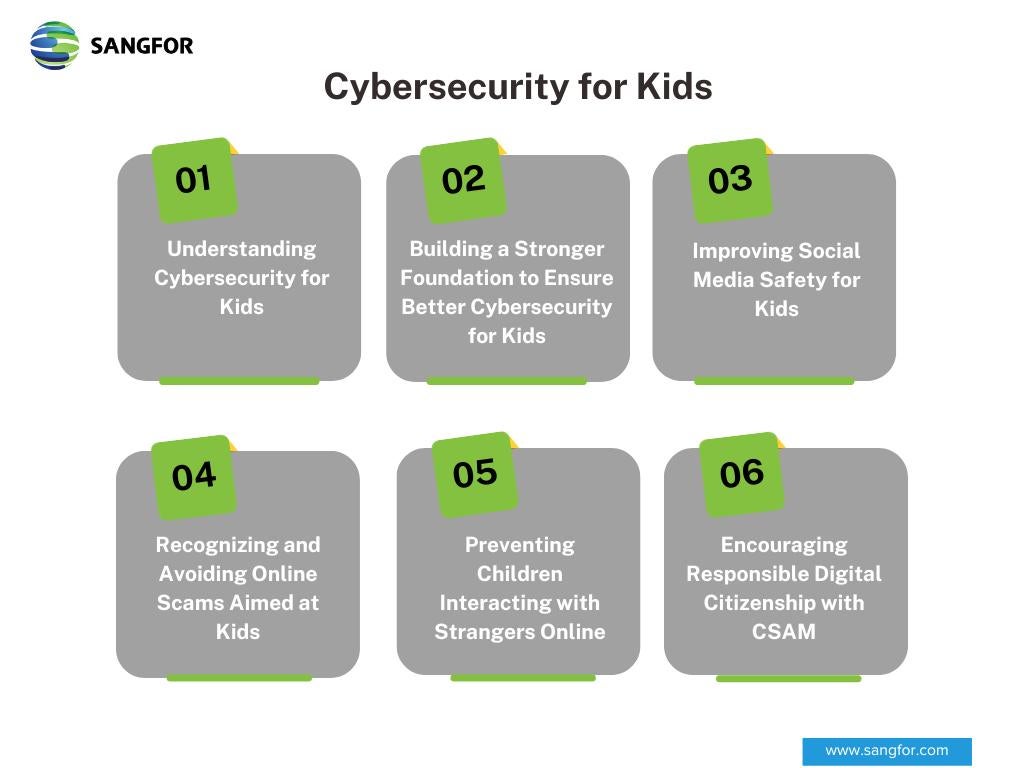Children are key to creating a better future for us all. With youthful ambitions, optimism, and the world at their fingertips - kids are often placed at the forefront of the modern age. New technologies, platforms, and products are always aimed at children first because of their highly impressionable minds. However, these traits also make them a prime target for cyber threats in an increasingly digital world.
Children are exposed to large amounts of screen time in their daily lives - from cell phones to PCs. According to CISA, a child between 8 and 18 years old will spend 7 hours and 38 minutes online per day. This time can be spent on social media, gaming, media consumption, and more. However, there are always risks and dangers aimed at children in the online landscape. This includes cyberbullying, phishing scams, viruses, identity theft, predators, and more.
Many governments are trying to curb the dangers to children in online communities by creating awareness. Recently, the Indonesian Minister of Women's Empowerment and Child Protection (PPPA), Bintang Puspayoga, called for the protection of children in the ASEAN regions from the adverse effects of technology. The digital threats that children face each day are growing. For this reason, we’ve put together a few guidelines to help you understand these evolving cyber risks a bit better and ensure improved cybersecurity for kids.

1. Understanding What is Cybersecurity for Kids
To properly understand cybersecurity threats, children need to have a firm understanding of what cybersecurity is. Cybersecurity is the set of practices, tools, and techniques that are used to keep you safe from harm when you’re online. This can range from installing antivirus tools to being cautious about links online. Almost every kid has a phone, tablet, or PC – which makes instilling proper cybersecurity awareness and practices that much more important.
Children have access to the internet from a very young age and are constantly being exposed to potentially dangerous content. Some of the most common cyber threats to children include:
The Threat of Cyber bullying
Cyber bullying is a form of online harassment that can include text messages, pictures, or the spread of misinformation. Cyberbullies will use the mask of online anonymity to spew hateful comments, threats, and more malicious sentiments. Some cyber bullies might even take to “doxing” their victims and exposing personal information online – leading to even greater cyber threats. However, the people behind the words spoken online can also be a danger. Sangfor has provided solutions at Rugby School of Thailand where one of the requirements was to protect kids from cyber bullying.
Cybersecurity for Kids Against Online Predators
The internet is a far-reaching platform that is open to anyone. Unfortunately, the online community can also be a great place for predators to lurk and lure in unsuspecting children. These sexual predators take advantage of a child’s innocence and trust to coerce them into sending explicit content, meeting in person, and more. These predatory figures could even convince children to fall for phishing scams as well.
Phishing Scams Targeting Children
The internet is also a good place for cyber-attacks to thrive. Children are often enticed by various phishing schemes and can be coerced into giving away confidential information online without even knowing it. Pop-ups for phishing scams are often found on websites that children and teenagers frequent such as online games, torrenting sites, and more. These scams can lead to the exposure of personal information and the injection of malware onto devices.
Cybersecurity for Kids Against Malware
Hackers rely on the naivety of their victims to carry out malware attacks. For this reason, the impressionable minds of children are ideal for downloading malware unknowingly. Malware files will be disguised as attractive and fun games or pop-ups that children are more likely to download. All of these threats and potential cyber-attacks can have a direct and indirect negative impact on a child
UNICEF has noted that children can suffer both psychological and physical harm from being targets of misinformation, disinformation, and hate speech. Children who are cyberbullied can be left alienated from their peers and are at a higher risk of developing behavioral problems and mental health issues later on. Cyber-attacks on hospitals, schools, and critical infrastructure also have a direct impact on the well-being, health, education, and safety of children. This is why we need to build a better foundation to teach children about the harms of the digital landscape.

2. Building a Stronger Foundation to Ensure Better Cybersecurity for Kids
- Best Cybersecurity and Ransomware Protection Practices: For children to stay safe online, parents and teachers need to actively teach them about best cybersecurity practices. Providing your child with a phone or laptop needs to come with certain responsibilities that they need to know are important. This includes the creation of strong and secure passwords for all their accounts. Strong passwords will have at least eight characters and use a combination of letters, numbers, and symbols. Children should be taught not to share their passwords with anyone – even their friends.
- Value your personal information: Children also don’t value the concept of personal information that much. Adults need to explain the vastness of the internet and how personal information can be used to hack accounts, answer security questions, and lead to much more severe consequences – physically, financially, and psychologically. Private information such as full names, addresses, dates of birth, ID numbers, and more need to stay concealed and protected at all times.
- Software Updates: Kids often want the latest technologies and devices but can be lazy when it comes to updating software. Teach your children why software updates are necessary to protect your information and device. Existing vulnerabilities can be easily avoided with the patches in a simple update.
- Participate in CSAM 2023: Teaching your children the foundations of cybersecurity can be easier when you emphasize its importance by recognizing and participating in campaigns and activities such as Cybersecurity Awareness Month. During Cybersecurity Awareness Month – or CSAM – try to involve your children by joining kid’s cybersecurity workshops, spreading awareness, or creating a detailed infographic - such as a cyber bullying poster. Moreover, parents need to address one of the main ways that cyber threats reach kids – which is unchecked access to social media.
3. Social Media Safety to Regulate Cybersecurity for Kids
Social media apps are built to generate traffic and keep users scrolling for longer. Children have much shorter attention spans and apps will take advantage of this to keep them engaged for longer. Social media is a great way to make friends, stay informed, and keep in touch, however, it can also foster self-esteem issues, fatigue, and waste a lot of valuable time.
Children are less aware of a digital footprint and tend to post everything that comes to mind. If you’ve ever met a child, you’d know that those thoughts aren’t always things to be proud of later on. While you can delete posts, nothing on social media is ever entirely erased. Teach your children to post responsibly, be respectful, and maintain a good image online to prevent damage later on in life.
Social media platforms are also rife with cyber bullying and “trolls” that spread harassment. Teach children to report and block abusive accounts to keep their online space safe. Kids should also never send inappropriate or explicit pictures of themselves to anyone online. Children need to feel comfortable enough to confide in a trusted adult without being judged if they are being bullied or coerced in any way online.
Privacy settings are a great way social media accounts can keep your posts and content within a select bubble. Go through the privacy settings and discuss how to adjust them according to who should have access to your posts. Private accounts give children the ability to curate their followers and only give trusted friends access. Facebook, Instagram, and other apps all have advanced privacy settings that can ensure children have a safe online experience. These settings can also help kids avoid the startling number of online scams being directly aimed at them.
4. Recognizing and Avoiding Online Scams Aimed at Kids
Phishing scams will often target children as they’re more likely to click on bright and shiny pop-up messages and links. A study found that people under the age of 20 lost US$ 101.4 million to online scams in 2021 - marking the highest increase of any age group over the five years according to the FBI IC3. While children are considered the more tech-savvy generation, they are also still kids. The overconfidence of kids using technology in the modern age has made them careless. Some common online scams targeting children include:
Fake Websites Directed at Kids
These can be retail store websites, movie torrenting sites, and other false web pages. Children are under constant pressure to dress a certain way, consume certain media, and fit in. This makes them vulnerable to using fake websites that steal your personal information, banking details, and more. These sites can also have pop-ups that push you into unknowingly making in-app purchases.
Kids Unknowingly Making In-App Purchases
Modern parenting has introduced an entire generation of “iPad Kids” who are given a tablet or phone to watch YouTube videos or play games while exhausted parents tackle daily tasks. While this can be effective, it can also leave kids vulnerable to clicking on random in-app purchases hidden in games that require your banking details – or rather the parent's banking details. Kids can unknowingly rack up quite the bill for an unsuspecting parent by pressing these links. Often, these links can even come from catfish accounts that kids trust without a doubt.
Catfish Accounts Deceiving Children
The modern age has made it possible for anyone to create an account using another person’s name. Teenagers are often targeted by people pretending to be celebrities or friends who then establish a false relationship and can persuade them to send money, explicit content, and personal information. Catfish accounts can also push for children to enter specific fake competitions as well – for example, a catfish posing as your favorite celebrity asking you to enter your information for a lucky draw to see them.
Fake Competitions Targeting Kids
Hackers can send messages to kids telling them they’ve won a specific prize after participating in a social media challenge or talent competition. They then ask for banking details and personal details only to disappear completely. Other messages will include a link that immediately downloads malware onto your device and gains access to your account. Children need to be taught the importance of avoiding suspicious links and messages online to outsmart modern hackers.
Hackers will direct message kids in the hopes that it will build trust and establish a line of connection. Parents and teachers should remind children to always be skeptical before making purchases online. The Google Play Store and other app stores often have child safety controls that alert a parent immediately if any purchase is taking place. Another worrying threat is the strangers behind these online accounts that children freely interact with.
5. Children Interacting with Strangers Online
A survey showed that 43% of children between 8 and 13 years old are talking to people they have never met in real life on social media and gaming platforms. The study further revealed that more than half of that percentage had given their phone number to a stranger, one-fifth spoke with a stranger over the phone and 11% went as far as to meet a stranger in their own home, the stranger’s home, a park, or a mall.
The concept of “stranger danger” also applies online. While the internet can be an exciting place to make new friends and form new connections, it can also be filled with sexual predators, stalkers, and cybercriminals. Teach your children not to interact with strangers online or add strangers to their friend lists without parental consent. Kids need to understand that not all people can be trusted regardless of how they present themselves – it’s always better to be safe than sorry.
Your child also needs to know the value of personal and private information. Research showed that one in four children between the ages of 6 and 12 have shared personal information online with strangers. Private information can be used to hack accounts, steal money, and find exact locations. Kids need to immediately report suspicious behavior to an adult to mitigate any lasting damage. It is your job to teach children active and responsible digital citizenship when they are online.

6. Encouraging Responsible Digital Citizenship with Cybersecurity Awareness Month (CSAM)
Children are like sponges in the way they absorb information. This can be both a blessing and a curse. Children who are constantly exposed to hateful comments, misinformation, and inappropriate content online are more likely to project that same behavior in their own lives. This has led to the emergence of communities built upon racist, misogynistic, and abusive cultures that feed directly into our realities.
Responsible online behavior includes treating others with kindness, respect, and dignity. The behavior that we ignore is the behavior that we encourage in children. This is why adults need to teach responsible digital citizenship from a young age. Regardless of their upbringing, children will be exposed to a lot of content designed to change their opinions. You must keep them on the right path and guide them to making responsible decisions online.
Growing up means learning about consequences and children need to know that actions online can and do have real-life consequences. Teach kids that their digital footprint will matter for most careers and that they cannot afford to throw away their futures for a few likes online. Try to foster a relationship with your child that encourages openness about their experiences online so you can always be aware of their activities and provide help if needed. One of the ways to ensure the best cybersecurity for kids is to simply invest in better cybersecurity solutions and platforms.
Sangfor's Success Stories at Universities and Schools for Kids Cybersecurity
Sripatum University (SPU) - Thailand
Sripatum University (SPU) was facing challenges in providing a safe and secure working environment for students. This was due to Open-source software without proper configurations, issues with existing firewalls, and weak infrastructure. Sangfor Technologies’ solutions improved security and performance. Sangfor’s Next-Generation Firewall and SSL VPN resolved issues, creating a secure and efficient network environment for the university. Read the Sangfor's detailed success story on Sripatum University (SPU)
Universitas Gadjah Mada - Indonesia
The challenge was to secure the university's vulnerability to cyber threats, which threatened sensitive data. The solution involved implementing Sangfor's cybersecurity solutions to enhance the university's security posture and protect its critical information. Thus by securing all students' data and protecting their future. Read the full success story here.
Rugby School - Thailand
Rugby School Thailand faced challenges with network security and remote learning. Leading to cybersecurity risks for kids for their data security. Sangfor provided a solution by implementing their Next-Generation Firewall and VPN, enhancing security and enabling seamless remote education for students and staff. This ensured a secure and efficient learning environment despite the challenges posed by the pandemic. Read the full success story here.
Keeping Safe with Better Cybersecurity for Kids
The online landscape is constantly evolving and expanding with innovations. The youth are at the center of this drastic growth spurt and are often the initial target market for the technological age. While this can be exciting, children must understand the cybersecurity risks they take online and the real consequences of their actions. Adults need to actively monitor a child’s online activity and be active in protecting them from the harms of the internet.
Some resources that parents can use to further their understanding of keeping children safe online include:
- The National Cybersecurity Awareness Campaign Kids Presentation
- The Nemours Kids Health Blog
- A Cybersecurity Awareness Month 2023 Resources and Partner Toolkit
- The CISA Cybersecurity Awareness Month 2023 Webinar Series
- US Department of Justice’s Keeping Children Safe Online
- UNICEF How to keep your child safe online blog
- Internet Matters Helping Parents Keep their Children Safe Online
Cybersecurity for kids is a growing issue, and there are many dangers that kids face in the digital world – from strangers online to phishing scams. Kids need to be educated and have access to resources that will help to defend themselves. Sangfor specializes in providing advanced and integrated cybersecurity measures to schools & universities to keep children safe online. Contact Sangfor today for more information by visiting www.sangfor.com.





